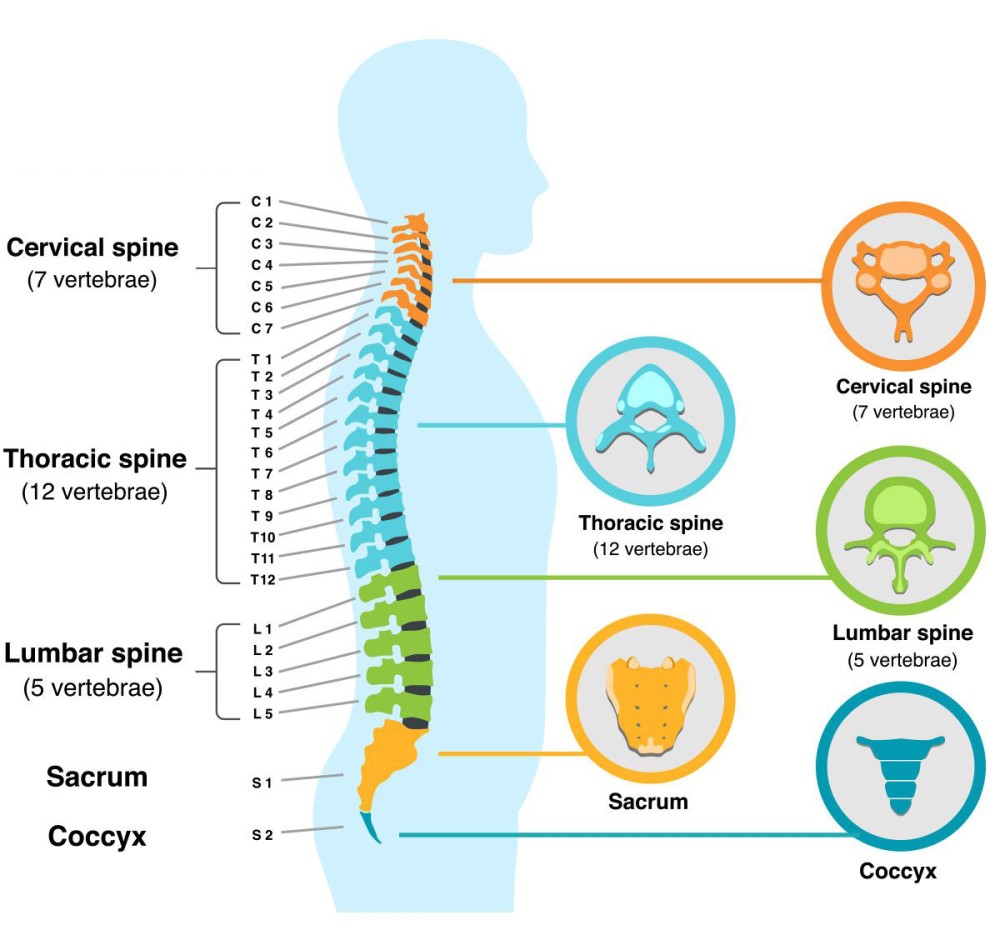What is spinal fusion?
Spinal fusion is a surgery that permanently joins two or more vertebrae together. The procedure stops any movement between the joined vertebrae.
The surgery can help to:
- Straighten a crooked spine or spine curvature
- Improve breathing
- Reduce back pain
- Improve sitting and balance

Who benefits from spinal fusion?
Kids who have a variety of conditions can benefit from spinal fusion surgery.
Idiopathic Scoliosis (Adolescent Scoliosis)
When conservative treatments, such as bracing, aren’t effective, kids who have scoliosis with spinal curves greater than 45 to 50 degrees can be candidates for spinal fusion surgery. The surgery straightens the spine by releasing some of the ligaments and joints around the spine and inserting metal rods to hold the back in a straighter position.
Spondylolysis and Spondylolisthesis
When spondylolysis and spondylolisthesis don’t respond to nonsurgical treatments or when vertebrae press on nerves, limited spinal fusion surgery can help to relieve pain.
Scoliosis Caused by Cerebral Palsy
Sometimes cerebral palsy causes the brain to send abnormal signals to the muscles that control the spine, leading to a curved spine. If bracing doesn’t effectively slow the progression of severe spine curvature, spinal fusion surgery can help to correct spine curvature, improve posture and alleviate the need to use hands and arms to support the upper body
Scoliosis Caused by Spina Bifida
Myelomeningocele is a type of spina bifida in which the spinal cord and bones of the spine don’t form normally. Some kids who have this type of spina bifida can have decreased muscled control that leads to a curved spine. Spinal fusion surgery can help to correct spine curvature, improve posture and alleviate the need to use hands and arms to support the upper body.
Scoliosis Caused by Neuromuscular Conditions
Sometimes neuromuscular conditions, such Duchenne muscular dystrophy, Becker muscular dystrophy and spinal muscular atrophy cause progressive spine deformities that decrease lung capacity. In these cases, spinal fusion surgery stabilizes the spine, which can help kids be more comfortable and breathe easier.
How do I prepare for spinal fusion surgery?
You can help make sure your child has the best possible outcome by understanding what to expect before, during and after spinal fusion surgery at Gillette Children’s. Here are a few resources to help you feel more prepared:
- Review tips to prepare for surgery at Gillette
- Understand the amenities available at Gillette
You’ll hear from us—we’ll:
- Obtain a health history, including details about medicines (name, dose, frequency), pharmacy and primary care doctor
- Discuss what to expect on the day of surgery and during the hospital stay
- Let you know what you’ll need when your child leaves the hospital
Overall health can affect how well and how quickly your child recovers from spinal fusion surgery. Your child should maintain regular levels of activity and physical therapy before surgery. Eating adequate amounts of food with iron, calcium and vitamins C and D (fresh colorful fruits and vegetables, dairy food, and other products with added iron and calcium) is helpful, too.
Sometimes fears, behavior or expectations related to the upcoming surgery cause stress for families. Contact your child’s primary health care provider or Child and Family Services for support.
Gillette can help with resources that might help reduce anxiety for all of your family members. Our child life specialists can provide emotional support and distractions (such as toys and movies we can bring to the preoperative waiting area before surgery begins). Child life specialists also can meet with your child’s siblings to address their feelings and concerns.
Knowing what to expect can help everyone feel more prepared. We’ll be sure to help clarify short- and long-term expectations for outcomes following spinal fusion.
Gillette is a latex-free facility, but it’s still important to tell us if your child has a latex allergy or has ever had a severe reaction to latex.
What to expect during your hospital stay for spinal fusion?
Arrival
The Perianesthesia staff greets you upon arrival. Your child is weighed and asked to change into a hospital gown. We also check temperature, pulse and blood pressure. A child life specialist helps your child feel more at ease with toys, crafts or movies.
Surgery Preparation
Next, you and your child meet with the surgery team: nurses from the preoperative area, operating room and postanesthesia care unit; surgeon, nurse anesthetist and anesthesiologist. This is time for you to raise any questions or concerns—the anesthesiologist discusses how anesthesia and pain medication are used during surgery. You might talk about your child’s experiences with pain and request medication or other techniques to help decrease anxiety.
Surgery
During a spinal fusion in a state-of-the-art surgery suite, the orthopedic surgeon makes an incision in your child’s back or side to reach the spine.
The surgeon attaches bones of the spine together using screws or hooks. Next, the surgeon removes the joints between the bones and attaches the hooks or screws to a rod. Your child’s spine is then repositioned so that it is straighter. The surgeon tightens the screws or hooks to make sure they are firmly attached to the rod. Finally, the surgeon places a bone graft along the spine to help the bones of the spine grow together.
Coming Out of Surgery
Following the operation, your child starts out at the Postanesthesia Care Unit (PACU)—this is where they wake up and you join them. Shortly afterward, nurses ask your child about pain and provide medication for pain management and comfort if needed. The surgeon meets you in the PACU to discuss the surgery and recovery process.
Depending on age, your child then moves to the Orthopedics/Surgical Unit or the Adult Unit.
Shortly after surgery, you might notice temporary changes in your child’s appearance. For example, their face and hands might be puffy due to body position during surgery. There might also be redness around your child’s eyes and lips. That’s because we often place protective tape over the eyes and around the mouth to keep the breathing tube in place.
After Surgery
Following surgery, your child will have a dedicated care team, including an orthopedic surgeon and pediatric orthopedic nurse practitioners. Members of the care team will check in every day during the hospital stay to check the incision and review progress.
Physical therapists might visit your child to monitor strength and the ability to move safely. If able, your child will be encouraged to sit, stand and walk the day after surgery.
Although each child’s experience is different, most kids stay in the hospital for three to seven days after spinal fusion surgery. Most kids who have idiopathic scoliosis are ready to go home in three to four days. Children who have scoliosis associated with cerebral palsy, spina bifida or muscular dystrophy are typically ready to go home five to seven days after surgery.
Before going home, the care team will ensure your child:
- Has adequate pain management with oral medication, which is typically needed for two weeks following surgery
- Can urinate and have bowel movements without difficulty
- Can eat and drink well
- Can get up and out of bed easily
Rehabilitation and Recovery
Spinal fusion surgery recovery usually takes a few weeks. The speed at which your child recovers depends on his or her condition before surgery. Most of the time, kids resume normal activities—including going to school—within three to four weeks. Six weeks after surgery, your child will see an orthopedic surgeon for a follow-up appointment.
Spinal Fusion Services at Gillette Children's
At Gillette, you’ll have access to fellowship-trained pediatric orthopedic experts that specialize in spine surgery. Whether your child needs spinal fusion surgery to treat scoliosis, forward rounding of the back (also known as kyphosis), spondylolisthesis, or spine problems related to other complex conditions, our goal is to improve your child’s quality of life and prevent future health problems.
In addition to spinal fusion surgery, your child’s comprehensive treatment plan might include working with experts from a variety of specialties:
- Orthopedics and surgical inpatient care
- Pediatric intensive care
- Radiology and imaging
- Rehabilitation medicine
- Rehabilitation therapies
- Surgery
- Orthotics, Prosthetics and Seating
- Gait and motion analysis
- Minnesota’s first Level I Trauma Center for Children
- Adult Services (for older teens and adults)
 Home Page
Home Page

